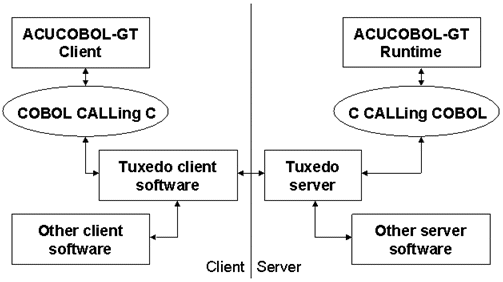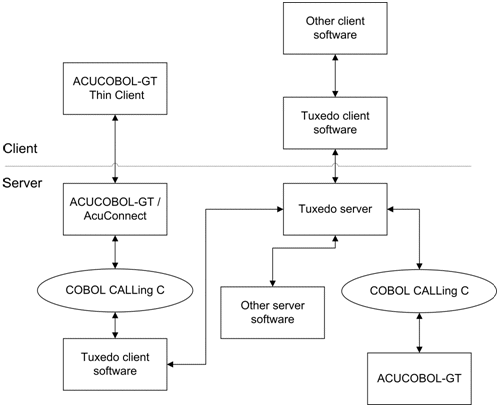Working With BEA Tuxedo
ACUCOBOL-GT developers using the BEA Tuxedo platform for distributed transaction processing and message-based application development can create Tuxedo clients and Tuxedo services from ACUCOBOL-GT applications. Acucorp is certified for Tuxedo 9.1 on all supported platforms.
ACUCOBOL-GT and BEA Tuxedo can work together in either a distributed processing (client/server) environment or a thin client
environment. In a distributed processing environment, the interaction occurs as shown in the following diagram:

In this environment, ACUCOBOL-GT interoperates with BEA Tuxedo using the same routines used to call C programs (COBOL-calling-C routines on the client and C-calling-COBOL routines on the server).
In BEA Tuxedo client/server distributed applications, the client requests the services of a server, which may have multiple services to provide, and the outcome of the request is returned to the client by the service. This architecture lets you divide application processing among multiple machines to optimize performance.
ACUCOBOL-GT and BEA Tuxedo can also work together using Acucorp's Thin Client technology. The thin client architecture uses AcuConnect®, Acucorp's remote application server, as shown in the following diagram:

Because BEA Tuxedo is based on C, the procedure for interfacing with Tuxedo is much like the procedure for interfacing with C routines in general. This means that external C variables need to be defined in "direct.c".
To prepare BEA Tuxedo to interface with ACUCOBOL-GT, C code must be added to the initialization and termination routines of BEA Tuxedo servers, then linked into the server using the BEA Tuxedo buildserver command. This process is further explained in the sections that follow.